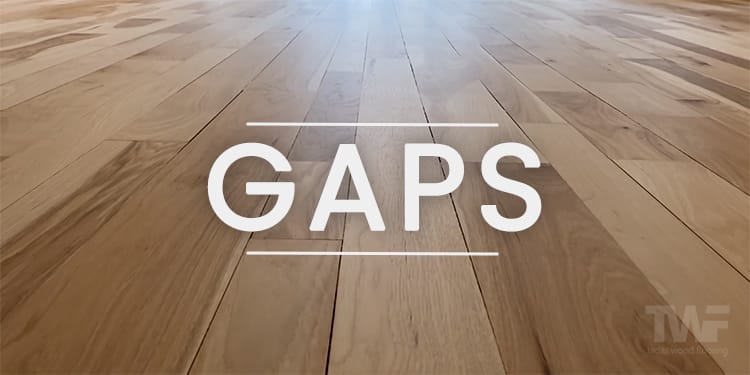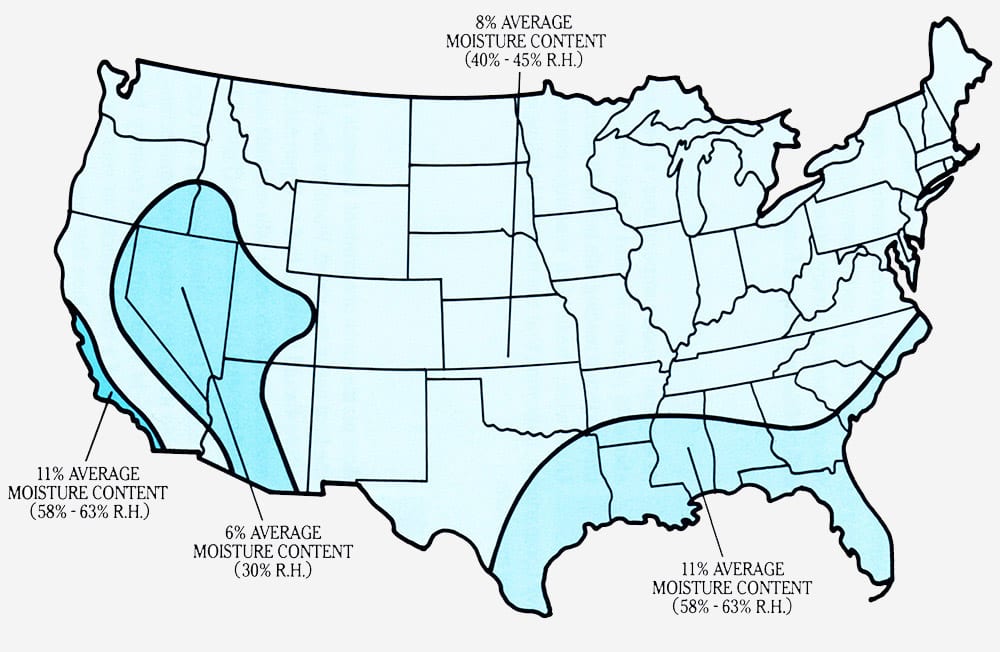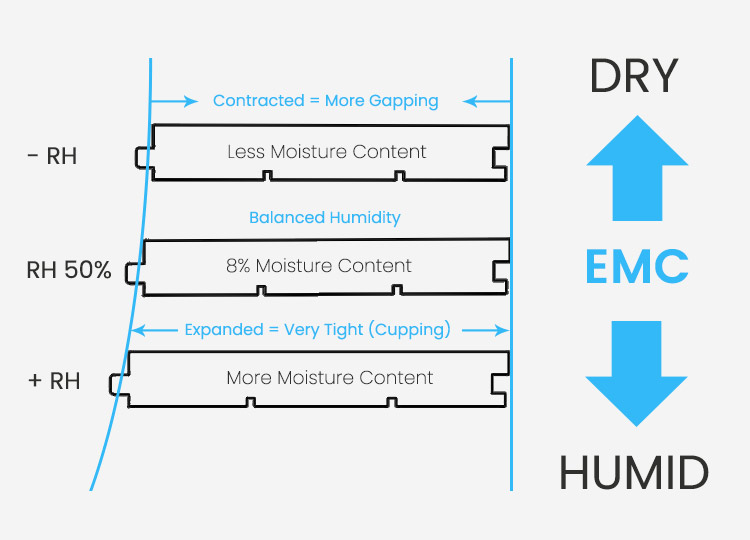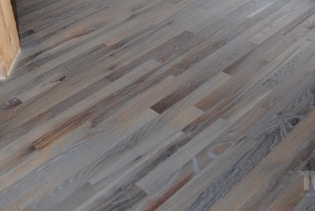Why Does My Hardwood Floor Have Gaps?
It’s that time of year again when I start getting asked the same question over and over… “Why does my floor have gaps?”, or some similar version of that like “Can you fill the cracks in my floor?”

It’s not fun to have your floors refinished and the boards are tight in the summer and then, just a few months later, when things start to get colder, they start opening and being full of gaps.
What on earth is going on? Is there something wrong with your floors?
Thankfully, for most hardwood floors the answer is no.
What you’re seeing happen is perfectly normal for all things made of wood in your home, including your wood floors. There is a very simple explanation for why some months of the year you see gaps in your floor and other months you don’t.
The Reason Hardwood Floors Have Gaps:
Put simply, wood is hygroscopic.
Something that is hygroscopic attracts and holds water molecules from the environment it’s placed in. For example… you may have been to a restaurant with a salt shaker that won’t let any salt come out because it’s all clumped up? The reason this happens is because the high humidity levels in the air cause the salt crystals to absorb moisture. Salt will expand to the point that it can’t come out of the tiny shaker holes.
This is exactly the same type of thing that happens with wood.

The moisture content of your hardwood floor will change depending on the relative humidity of the surrounding air in your home. The moisture content of the wood will increase as the humidity level in the air increases. This process will make the wood expand. In the same way, when the humidity level in your home drops, the moisture content in the wood decreases and it starts to contract and shrink.
The technical term for this process is Equilibrium Moisture Content (EMC).
Below is a map showing the regional EMC across the United States…

In the past you may have experienced wood doors in older houses that open, close and lock perfectly fine in the winter months. Then summer comes along with its humidity and the same doors start to get harder and harder to open and close, as if they’ve suddenly grown.
Those old solid wood doors are dealing with the same EMC issue.
Like these wooden doors, this expansion and contraction in hardwood floors is very noticeable in the seasonal changes between winter and summer.
In the hotter summer months your house is open, the humidity level in the air is higher and the wood in your floor absorbs moisture and fully expands. Then the colder winter months rolls around, you close your home up tight and crank up the heat. When you do this, the humidity level in your home drops and the wood in your floor releases the moisture it’s been holding and it begins to contract and shrink.
That’s when you start to see gaps forming.

It gets especially bad when we have runs of freezing cold days like we experience here in Naperville and Chicago. All of a sudden everyone’s furnaces are cranked right up. That’s when all the moisture starts getting sucked out of the wood and those dreaded gaps start appearing.
Thankfully these unsightly gaps will start to disappear when spring rolls around with its increased humidity levels and the heat gets turned down and eventually turned off.
But what if you don’t want to wait for summer? Is there anything that can be done to close the gaps a bit now and keep the floor tight throughout the year?
What Can Be Done to Control the Gaps?
One of the best ways to control the gaps in your hardwood floors is to keep the humidity level in your home the same throughout the year. Obviously, in order to do that you’ll need to add moisture to the air during the drier months.
The easiest way to do that is to invest in a humidifier and set it to 45 – 55 percent. (Gaps start to appear in your floor when the humidity level gets below 40 percent).
By doing that the relative humidity in your home will stay stable and your hardwood floors won’t expand or contract as much during the year – which means far fewer and also smaller gaps.
When it comes to humidifiers, you have two types to choose between.
The first kind is a permanent installation that’s connected to your furnace and works throughout the whole house. It gets integrated with the blower system and draws water directly from the houses main water supply. These humidifier systems are very low maintenance and quite reasonably priced.
Here’s a video I found on YouTube that describes this type of system (skip the first 30 seconds)…
The second type is a portable humidifier. There are small table top ones and larger free standing ones. The bigger free standing versions have wheels so they can be moved around from room to room. Most portable humidifiers will only humidify a small area at a time though and you will need to top up the water reservoir daily to keep them working.
Which type you choose will depend on 1) your budget, 2) the size of the area you need it to work in and 3) whether you want to constantly fill it with water or just install it and forget it.
A very valuable side benefit to a humidifier is that it will prevent all the wood in your home (doors, furniture, pianos etc.) from shrinking, cracking and splitting and it will also help you to have a healthier home environment.
In Conclusion…
So as you can see, if you have gaps in your hardwood floor there’s no need to panic. Wood is a natural product that predictably reacts to the environment it’s placed in. How much it expands and contracts completely depends on the weather and the humidity levels you maintain in your home.
By following the tips above and investing in a good humidifier, you’ll finally be able to limit the amount of gaps in your hardwood floors until summer rolls around once again.
–
Updated Jan 2023



I was hoping to get your expert advise. Love your website and blog. We currently have a dark cherry stained maple engineered floor. We had water damage so we must replace all the floors. We want to stay
with the dark/cherry stain(very elegant home) and were all set to install another maple dark stained floor with a thick enough wear layer to allow refinishing 2 times. But our installer said the product is
great, but that maple is so hard to stain a consistent dark stain, that in reality we would probably never be able to refinish the floor and be duplicate the factory applied color stain. Do you have any
recommendations? We do not want a photosensitive product as we have many large area rugs. Our current floor shows no visible difference in color under the rugs after 13 years of use.
Hi Alice,
Sorry to hear about you floors… I understand what a pain that must be :(
Your installer is right, it’s very hard to duplicate factory finished stains on maple floors. The reason being is that a lot of these prefinished maple floors have the stain mixed in with the finish and it’s
sprayed on in a controled environment with numerous thin coats.
To do it onsite the maple needs to be pre-treated to accept stain more evenly (it’s one of the hardest woods to stain)and then the stain is rubbed in and the finish system applied over the top. A very
different system. Is there another pre-finished product out there similar to what you had?
If you go for an onsite finish system, choose a high-end 2 part water based product like Pallmann Pal-X Gold, Basic Coatings StreetShoe or BonaKemi Traffic. These finish systems have good ultra-violet protection and wear extremely well.
Good luck in your project Alice!
Tadas